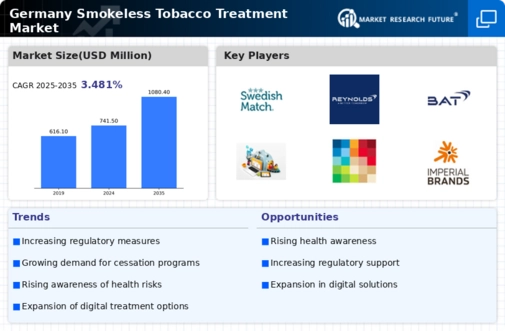Rising Healthcare Costs
The rising costs associated with healthcare in Germany are driving the smokeless tobacco-treatment market. As healthcare expenses continue to escalate, individuals are becoming more aware of the financial implications of tobacco use. This awareness is prompting many to seek treatment options to avoid long-term health issues and associated costs. In 2025, it is projected that healthcare costs related to tobacco-related illnesses will exceed €10 billion, highlighting the urgent need for effective cessation solutions. Consequently, the smokeless tobacco-treatment market is likely to benefit from this trend, as more individuals prioritize their health and seek affordable treatment options. The financial burden of tobacco use is thus a significant driver for the market, encouraging proactive health management.
Evolving Consumer Preferences
The smokeless tobacco-treatment market in Germany is experiencing a shift in consumer preferences towards healthier alternatives. As awareness of the health risks associated with smokeless tobacco increases, individuals are actively seeking effective treatment options. This trend is reflected in the rising demand for nicotine replacement therapies and counseling services. In 2025, the market is projected to grow by approximately 15%, driven by consumers' desire for safer alternatives. The increasing inclination towards natural and organic products also influences this market, as consumers are more likely to choose treatments perceived as less harmful. This evolving consumer behavior is reshaping the smokeless tobacco-treatment market, prompting companies to innovate and adapt their offerings to meet these changing demands.
Government Initiatives and Support
Government initiatives play a crucial role in shaping the smokeless tobacco-treatment market in Germany. The government has implemented various programs aimed at reducing tobacco use and promoting cessation. For instance, funding for public health campaigns and cessation programs has increased, leading to a more supportive environment for individuals seeking treatment. In 2025, it is estimated that government funding for tobacco cessation programs will reach €50 million, significantly impacting the smokeless tobacco-treatment market. These initiatives not only raise awareness but also provide resources for individuals, thereby encouraging more people to seek help. The collaboration between government bodies and healthcare providers is likely to enhance the effectiveness of treatment options available in the market.
Technological Advancements in Treatment
Technological advancements are significantly influencing the smokeless tobacco-treatment market in Germany. Innovations in treatment methods, such as the development of mobile applications and telehealth services, are making it easier for individuals to access support and resources. In 2025, the market is expected to see a 20% increase in the adoption of digital health solutions, which facilitate remote consultations and personalized treatment plans. These technologies not only improve accessibility but also enhance the overall effectiveness of treatment by providing real-time feedback and support. As more individuals embrace these technological solutions, the smokeless tobacco-treatment market is likely to expand, catering to a tech-savvy population seeking convenient and effective cessation methods.
Increased Collaboration Among Stakeholders
Increased collaboration among various stakeholders is emerging as a key driver in the smokeless tobacco-treatment market in Germany. Healthcare providers, government agencies, and non-profit organizations are increasingly working together to create comprehensive treatment programs. This collaboration enhances the availability and accessibility of treatment options, ensuring that individuals receive the support they need. In 2025, it is anticipated that partnerships between public health organizations and private sector companies will lead to the development of innovative treatment solutions, potentially increasing market growth by 10%. Such collaborations not only improve the quality of care but also foster a more integrated approach to tobacco cessation, ultimately benefiting the smokeless tobacco-treatment market.


















Leave a Comment